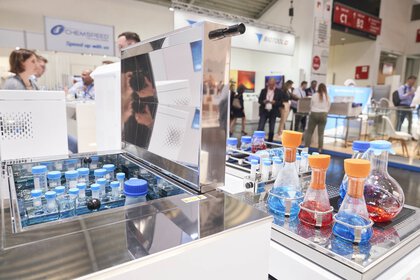Laboratory analysis: latest analytical methods and innovative developments
Discover the whole world of analysis in theory and practice, at analytica in Munich. Learn where laboratory analysis is headed.
Laboratory analysis with its finger on the pulse
Laboratory analysis includes the identification and quantification of inorganic and organic compounds. Using specific detectors and combinations of different detection methods, these compounds can be detected at ever lower detection limits. Today's instrumental analytical technology enables the detection of the smallest trace substances in the ppt range at the limit of quantification.
More than any other trade fair platform, analytica in Munich is a source of crucial information on the latest developments in laboratory analysis. Over 900 internationally renowned exhibiting companies and market leaders from the global laboratory industry presented the latest laboratory analytical instruments and innovative analytical methods at the world's leading trade fair analytica in 2024.
Laboratory analysis focal points at analytica
All of the key cross-sectional technologies related to analysis will be represented at the world's leading trade fair analytica in Munich. The entire spectrum of analysis will be presented by international industry leaders.
- Sample preparation in the laboratory
- Elemental analyzers for elemental analysis
- Chromatography: accessories and methods such as DC, IC, GC, HILIC, HPLC, UHPLC, FPLC, and their coupling techniques
- Spectroscopic methods like IR, FTIR, UV/Vis, AAS, ICP
- Mass spectrometry and tandem mass spectrometry, MS couplings such as GC-MS, GC-MS/MS, GC-APCI-MS, HPLC-MS, HPLC-MS/MS
- Microscopy, imaging
- TGA and thermal analysis TA
- Measurement and control technology, sensors
- Sustainable laboratory analysis
Qualitative and quantitative laboratory analysis
Qualitative and quantitative laboratory analysis sets the pace for all areas of chemistry and its related industries such as pharmaceuticals, etc. This is because all innovations in the natural science disciplines are largely dependent on the detection capabilities of analysis. This is true of research and development, industry-related quality monitoring as well as purity and authenticity testing in a wide range of applications and application areas such as food fraud, pharmaceutical and active ingredient analysis, water and environmental analysis, trace and matrices analysis, and materials analysis.
Evolving methods that comply with laws and guidelines and meet FDA, REACH, GLP, GMP and ISO standards are crucial to ensuring that analysis adheres exactly to the guidelines.

Talk to the industry leaders analysis and laboratory technology
Renowned exhibitors from laboratory analysis will present the latest products and services. To see which big players and which up and coming companies from laboratory analysis will be at analytica go to our exhibitor directory.
At analytica 2024, for example, these were:










Saving energy and conserving resources in the laboratory
The global situation being what it is, the focus is increasingly on energy-saving solutions that are both climate-neutral and conserve resources, and which have wide-ranging potential applications in laboratory analysis. Helium gas consumption in chromatography in particular, especially in gas chromatography, is a significant cost driver in day-to-day operations.
The first detectors that turn impure helium (He) into high-purity He and thus help achieve substantial cost savings in the laboratory are already commercially available. Entire device systems, complete with helium alternatives are also in development. It remains to be seen what insights analytica will deliver on the subject of sustainability in the laboratory and Greenlab.

Wissenschaft meets Industry
The analytica conference is the science-oriented component of analytica. With around 180 lectures, it covers the entire spectrum of modern analytics and thus bridges the gap between research and routine analysis.

Be there now and secure your ticket for analytica!
With just a few clicks you can buy your personal ticket to analytica or redeem a voucher.
analytica: meeting place for the laboratory analysis
At analytica, visitors will find the right solutions to current problems in a wide range of analytical fields.
Food analysis and Bioanalysis
The focus is on allergens, flavors, cannabinoids, MOSH/MOAH and PFAS analysis concepts, mycotoxin analysis, novel food analysis and alternative protein sources, pesticide and residue analysis such as glyphosate and acrylamide analysis, Omics and PCR technologies, and bioanalysis in general.
At analytica, trade visitors will learn how mRNA vaccines and siRNA components can be analyzed in the laboratory and how the retention times and selectivities of oligonucleotides can be efficiently determined using ion-pair-free RPLC-MS with direct coupling of ESI-MS.
In addition to target analysis, non-target methods such as non-target screening (NTS) are becoming increasingly relevant, especially in the water sector (drinking water, surface water, wastewater) and in
food analysis.
PFAS analysis
PFAS are a highly topical and hugely contentious issue. This topic will be addressed at analytica, presenting developments including SPE columns for optimized workflow when preparing samples for PFAS analysis and the simultaneous detection of several different PFAS components (PFOA, PFOS) in a high-resolution mass spectrometer. All major manufacturers of equipment for PFAS analysis will be represented at analytica 2024, including Agilent, Analytik Jena, Bruker, Gerstel, PerkinElmer, Shimadzu, Thermo Fisher and Waters. At the analytica conference, PFAS will be the focus of the scientific community and will clarify questions such as how PFAS analysis can reliably detect the "eternaty chemicals".
Battery research
However, battery research and the analysis of battery by-products also remain a major focus in laboratory analysis. Increasingly, mobile analyzers are also being used for on-site applications.
Digital Lab
Learn how digital transformation has entered the laboratory world at analytica 2024. In Munich, besides current lab software for data evaluation and data storage, solutions to the pressing issue of interface problems and networking in the laboratory will be on show. Current issues around data integrity are of particular interest. Novel cloud-based systems for NTS analyses, for example, are designed to increase data security and improve communication between different laboratories.

